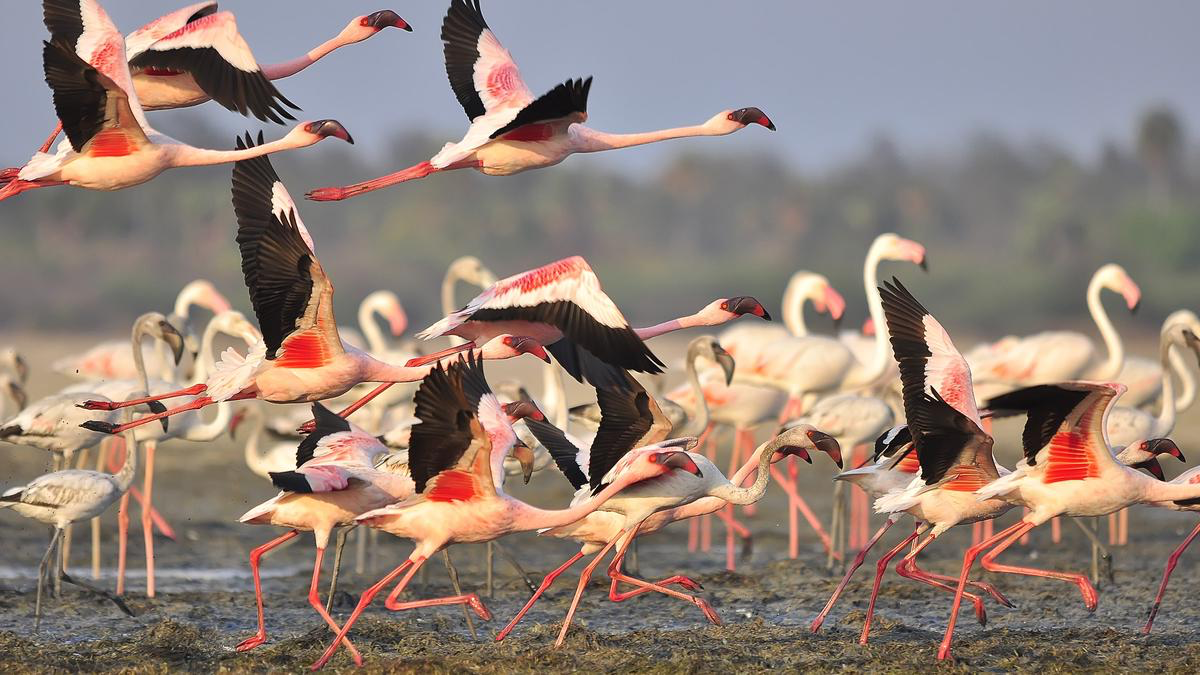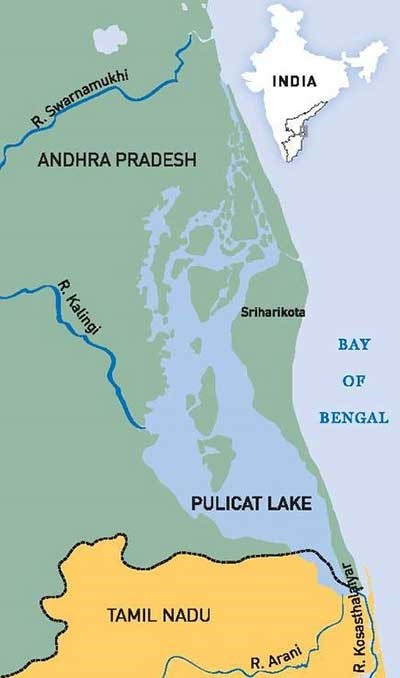Description

Disclaimer: Copyright infringement not intended.
Context
- After a six-year absence, the lesser flamingos, resplendent with deep red legs and bills, have finally found their way back to Pulicat lake.
About Lesser Flamingo
|
SCIENTIFIC CLASSIFICATION
- Common Name: lesser flamingo
- Kingdom: Animalia
- Phylum: Chordata
- Class: Aves
- Order: Ciconiiformes
- Family: Phoenicopteridae
- Genus Species: Phoenicopterus (crimson winged) minor (smaller)
|
Description
- The lesser flamingo is a tall, large-bodied bird with a long neck and small head.
- Most flamingos, including this species, have pale pink plumage, legs, and bills.
- The lesser flamingo is one of the smallest and the brightest of the flamingos.
Size
- Approximately 80 to 90 cm long; females tend to be smaller than males.
Diet
- This species has a highly specialized diet consisting almost entirely of microscopic blue-green algae and benthic diatoms found only in alkaline lakes, salt pans and saline lagoons and estuaries.
- To a lesser extent, the species will also take small aquatic invertebrates such as rotifers.
Range
- These birds are found primarily in eastern and southern Africa.
- However, small populations exist in western Africa, Madagascar, Yemen, Pakistan, and India.
Habitat
- The species breeds on large undisturbed alkaline and saline lakes, salt pans or coastal lagoons, usually far out from the shore, after seasonal rains have provided the flooding necessary to isolate remote breeding sites from terrestrial predators and the soft muddy material for nest building.
Status
- IUCN: Near Threatened
- CITES: Appendix II
Fun Facts
- The name flamingo is originally derived from the Portuguese language and means "red goose," which is a reference to their flying formation and the noise they make.
- Lesser flamingos are believed to be the most numerous and live in the largest flocks.
- Some flocks are known to contain up to one million lesser flamingos and several thousand greater flamingos (Phoenicopterus ruber roseus).
- The lesser flamingo is an obligate filter feeder and feeds during the night and early morning when the surface of the water is calm, primarily by swimming and filtering the algae near the surface with a specialized bill that contains up to 10,000 microscopic lamellae.
- Flamingos are an ancient group of birds. Their fossil records dates back to the Miocene epoch, which is about 10 million years ago.
- Flamingos are not born with their beautiful pink plumage. Their color comes from the carotenoid pigments they consume as part of their diet. Some scientists believe that a flamingo's success in breeding relies on its bright color.
- These birds are unique because both the male and female provide their young with a type of nourishment called crop milk.

About Pulicat Lake
- It is the second largest brackish water lagoon in India, (after Chilika Lake), measuring 759 square kilometres.
- Major part of the lagoon comes under Tirupati district of Andhra Pradesh.
- The lagoon is one of the three important wetlands to attract northeast monsoon rain clouds during the October to December season.
- The lagoon encompasses the Pulicat Lake Bird Sanctuary.
- The barrier island of Sriharikota separates the lagoon from the Bay of Bengal and is home to the Satish Dhawan Space Centre.

|
PRACTICE QUESTION
Q) Which of the following statements with reference to Lesser Flamingo is/are incorrect?
a. These birds are found primarily in India and Pakistan.
b. Flamingos are not born with their beautiful pink plumage.
- a only
- b only
- both a and b
- neither a nor b
Correct Answer: 1
|

https://www.thehindu.com/sci-tech/energy-and-environment/a-flamboyance-of-lesser-flamingos-have-arrived-at-chennais-pulicat/article66776533.ece












